|
 |
|
George Naylor on his farm near Churdan, Iowa. Photos by Nic Paget-Clarke.
|
|
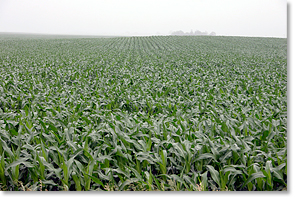 |
|
A field of corn on a misty morning. The George Naylor farm, Churdan, Iowa. For a larger version, see: Photo of the Week 445
|
|
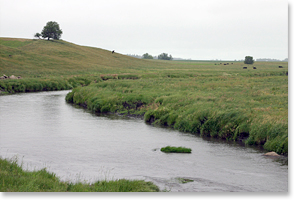 |
|
Hardin Creek, near Churdan, Iowa.
|
|
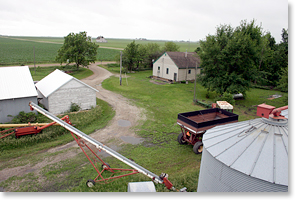 |
|
Part of the Naylor farm.
|
|
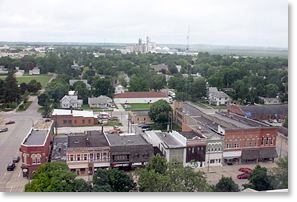 |
|
Close to Churdan is Jefferson, Iowa. Grain elevator, by a railroad, in the background.
|
|
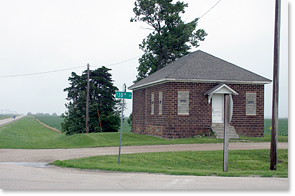 |
|
A little red schoolhouse. George Naylor: "There was a country school, I think it was approximately every three miles. I think no kid had to walk more than three miles to get to a country school. They would have grades one through eight and the teacher, one teacher, would teach all eight grades."
|
|
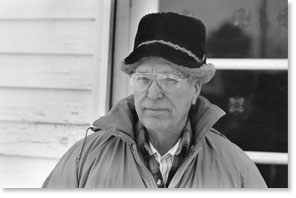 |
|
Merle Hansen, past president of the North American Farm Alliance on his farm in Nebraska, 1993. To see a larger version: Photo of the Week 396
|
|
 |
|
From on top of a Naylor farm grain storage bin.
|
George Naylor is an independent farmer and past president of the National Family Farm Coalition. The interview was conducted (and later edited) by Nic Paget-Clarke for In Motion Magazine on June 22, 2011 in George Naylor’s home on his farm near Churdan, Iowa.
People learned to live together
In Motion Magazine: What do you farm here?
George Naylor: I farm approximately 470 acres and I raise corn and soy beans. I have a garden and apple orchard and raise chickens when the varmints aren't eating them.
In Motion Magazine: How did you come to live here?
George Naylor: When I was born, my dad's family owned this farm and so I grew up on the farm up through eighth grade. Then, I moved to California because my folks moved to California. Eventually, after going to college out there, and staying out of the draft, I ended up thinking I was going to be a teacher. But I decided I didn't want to be a teacher. I got bit by the back-to-the-land movement. Eventually, after not living on a commune like I thought I might, my family was supportive in me coming back to the farm to farm.
It was kind of a boom time then, so they felt like I could make a living. They were supportive, in terms of helping me with the money to get started. I had actually worked for my other uncle on my mom's side of the family who had been farming the farm for a year and a half. I worked with him for a year and a half. I learned a lot about farming that I hadn't learned when I was a kid.
In Motion Magazine: You mentioned to me earlier that your mom was a country school teacher?
George Naylor: Yes. My mom's family, they had nine kids and they were quite poor when they were kids. My mom went to live with other people to help take care of their kids when she was nine-years-old and sent the money back home. She eventually went to normal school, I think they call it, at Iowa Teachers College, in Cedar Falls, to become a country school teacher. Later on, she became a postmaster, before I was born.
My dad and all of his siblings, and my mom and her siblings all went to country schools. There was a country school, I think it was approximately every three miles. I think no kid had to walk more than three miles to get to a country school. They would have grades one through eight and the teacher, one teacher, would teach all eight grades.
She (my mom) had a lot of stories about how she was able to use the kids to teach each other and how they all were very much like a family and learned to support each other. Back then, there was a lot of different ethnic origins for the people. There were Swedes and Danes and Norwegians and Germans and Dutch and English and Bohemians. They had all their different religious traditions. In her school she had atheists, I think they were Danish. And Norwegian Lutherans and Bohemians, who I think were estranged with the Catholic church.
And she told the story about she had to come up with a Christmas program, a traditional Christmas program but the atheists didn't really want to have Jesus in the program, and the Christians didn't want to have Santa Claus in the program. But she was able to put together either a non-religious or non-Santa Claus commercial-type Christmas program and they all seemed to think it was just great.
That was pretty great and people learned to live together and respect each other.
Farming was fun
In Motion Magazine: Can you say a little more about how you came to be a farmer?
George Naylor: My grandparents on both sides of the family had been farmers, and I always thought when I was a kid, farming was fun. When I grew up, I learned things very concretely. I couldn't imagine what other people did. I knew what farmers did. I knew what my dad did. But I didn't know what other people did. I thought it was neat thing to be a farmer. But we moved to California. So, I always thought farming was a really good thing.
In the meantime, when I was in college, my aunt sent me a subscription to Rodale's Organic Gardening and Farming Magazine. And the natural food movement came along. Then, the back-to-the-land movement came along. I don't know how that all seeped into my thinking, but it did. And then the whole idea of dropping out of society. I was a war protester. There was a lot of reasons that I didn't think that most options made very much sense.
(So, as I said before) when I really decided to not teach school, coming back to the family farm, I had all kinds of support from my family -- on both sides of the family -- to become a farmer. They were thrilled.
The farmers' crisis of the '80s: debt
In Motion Magazine: We talked earlier about different stages of the farmer movement. Maybe we could talk about two or three aspects of that. Why was there a farmers' movement, specifically in the '80s, for example?
George Naylor: In the '70s, -- maybe it's a longer story. It goes way back.
The New Deal farm program (1930s-1940s) tied prices to inflation through a parity mechanism -- adjusting a floor under prices tied to a parity ratio. (Editor's note: parity means the farmer receives a fair price -- at least the cost of production plus a fair profit -- in return for their produce.) And those were done away with in 1954 with the passage of the Hope-Aiken Bill. (In fact,) one of the reasons my folks left the farm in 1962 was tough times on the farm because farm prices hadn't increased for a whole decade.
(Anyway), in 1971, Nixon closed the gold window which meant that other countries couldn't convert their dollars into gold any more. That gave the Federal Reserve the ability to print dollars and start an inflationary trend. Commodity prices skyrocketed, and that skyrocketing was a product of that kind of monetary situation. It is very similar to the situation we have today with farm prices going sky-high in the midst of the Federal Reserve printing trillions of dollars. This is supported by a paper by an economist at Stanford University called (Ronald) McKinnon. http://economics.stanford.edu/faculty/mckinnon
So, it seemed like (for example), when I was making a decision to farm, I could make a living on the farm. Prices were good. But, by the time I actually started farming, and by the time I got my first harvest, and then my second harvest, the price of corn had dropped by fifty percent. The price of wheat had dropped a year sooner. The American Agricultural Movement got going out West because of the drop in wheat prices.
And, because of those inflationary times, when the commodity prices were higher, you had Earl Butz (Secretary of Agriculture under both Presidents Richard Nixon and Gerald Ford) say "plant fencerow to fencerow," "the world needs your food," "you don't have to worry about prices, anymore." People tended to sell their cattle to plant corn and soy beans which made the price of cattle plunge even faster so even more people wanted to get out of cattle. And they did. They planted corn and soy beans. Eventually, you got a situation where commodity prices were crashing.
That's my two first years of farming.
Plus, because of that early enthusiasm when Earl Butz was telling everybody to plant fencerow to fencerow, people were buying new machinery. Bigger tractors to plant fencerow to fencerow. When you had that many more acres you had to have bigger tractors. Bigger planters. Bigger everything. There was a lot of debt run up.
And people were buying land. The price of land went up. Just like it has today. People had racked up a lot of debt. Then, when prices crashed, well, hell, people weren't able to make payments on their loans. Eventually banks started calling loans.
That was the farm crisis of the '80s. That's basically how it happened.
The North American Farm Alliance: the goal of parity
In Motion Magazine: And was part of the response of the farmers then the large conference in St. Louis of ranchers and farmers?
George Naylor: Well, yes, though that was really quite a while after. The Farmers and Ranchers Congress that was sponsored by Farm Aid in St. Louis -- that was '84. The tractorcades organized by the American Agricultural Movement were in '77 and '78. There had already been a lot of farmers organized or involved in the American Agricultural Movement. There were some new organizations started, organizations that became more farm-oriented than they had normally been.
And you had the North American Farm Alliance that was organized to try to bring together a lot of the different groups around the country into a national organization that was really focused on the farm policy and of course the crisis situation. It helped facilitate organizing that United Farmer and Rancher Congress.
In Motion Magazine: What were some of the positions of the North American Farm Alliance?
George Naylor: One thing about the North American Farm Alliance, we saw the crisis as an international crisis. It had been the policy of the U.S. government to export its surpluses which influenced a lot of other countries around the world. Even back then, farm prices tended to go up and down together all over the world. Even then, they were tied together by international markets. It only takes a small amount of linkage between those markets to have that kind of influence. A country doesn't have to import a whole lot of grain for instance to have their local markets effected.
I don't know that we had Mexican farmers in our alliance, but we had Canadian farmers. The understanding was that the U.S. Farm Bill effected the prices of farmers all around the world. The Farm Bill in the United States had acted as the balance wheel to keep U.S. surpluses in line and off the market to a certain extent, which needed to be done, and therefore, also, the U.S. Farm Bill needed to be brought back to parity, the goal of parity like it was in the New Deal, so that the farmers around the world were assured a decent price.
That was our main focus. That farmers around the world be united in basic farm policy based on the principles of the New Deal Farm Policy, which would include international cooperation but recognize that the U.S. was the biggest grain exporter in the world and already had the mechanisms in place for regulating their supply so the United States could unilaterally, as far as that goes, at least temporarily make sure that the floor under prices were set at parity and that reserves were created and that we had supply management and conservation programs.
The North American Farm Alliance: Merle Hansen and focus
In Motion Magazine: The president of the North American Farm Alliance was Merle Hansen?
George Naylor: Yes.
In Motion Magazine: Do you want to say anything about Merle?
George Naylor: Merle's family, his dad and other relatives, had a long history of organizing farmers and agitating for a more representative government, that represented the average grassroots farmers and small business people.
Merle had a lot of stories about his own family, his dad having a car dealership. Besides being a farmer he had a car dealership and they lost that. Things like that -- and how they organized.
Then, when Merle got out of World War II, it wasn't long before he was speaking out for peace and working with the Iowa Farmers Union, and I don't know what other farmers unions, in various capacities.
He had a long history of supporting parity and a good representative government. He could give a wonderful speech so that people's eyes were filled with tears at the end of his speeches. He was just a tremendous person.
In Motion Magazine: How would you sum up the work of the North American Farm Alliance?
George Naylor: The thing is, it offered a way for a lot of smaller groups around the country, some of them created at the same time or even through of some of the efforts of the North American Farm Alliance, to get together where you could talk turkey, as Merle would say, about what was really important. Not just a bunch of baloney, having to worry about the status of the organization, and its relationship to politicians who weren't going to do any good for you anyway. It was true to its goals and welcoming of all kinds of people. People who had been influenced by right-wing politics, and left-wing politics, and all kinds of politics, but knew that there was a lot wrong with the situation and that grassroots democracy was the answer to all these problems.
National Family Farm Coalition
In Motion Magazine: You were president of the National Family Farm Coalition (NFFC) for a while. When was that?
George Naylor: You know, I don't know exactly what years, but it was approximately 2002 through 2006, or something.
In Motion Magazine: How was that experience?
George Naylor: It was a wonderful experience. Many of the groups that were in the North American Farm Alliance were also groups that were in the National Family Farm Coalition.
I guess one thing that it was always hard to get used to, and I probably never did get used to, but as time went on the orientation of all the groups didn't necessarily take into account what we thought we had understood and known back in the 1980s, or the 1990s, even. There were many more different kinds of groups than what we were dealing with back in the crisis days. Things had to be less focused than just on that farm bill and I think I tended to be mostly focused on the farm policy part, which I still think is absolutely important, at least for people to understand.
The mistake was to think that this government, this Congress would actually make any effort to move in that direction. That was a total mistake. I think we didn't think about generating a movement or becoming part of the bigger food movement when we should have.
In Motion Magazine: Did that change?
George Naylor: New groups were joining NFFC that helped new farmers create new markets and bring farmers and consumers together politically. When you look around, well, what movements have been successful, when you think of the kind of people we have had running our country, have any of our governments done anything really important, really good, as far as the environment goes, or urban poverty, or rural poverty, or anything?
I mean, hell, our government has just been a big business government the whole time. And the media too. Farm media does and says what big business wants people to think. The regular media, they have never been supportive until maybe with recent years with the local food type of concepts. But they are not educating people as to what the consequences are of our farm policy or our trade policy. They are pretty much all on the same page.
We did what we could and we tried to educate people as much as we could. Approximately 266 million acres of program crops -- corn, soybeans, wheat, cotton, etc. -- are raised in the U.S. and only 12 million acres of fruits and vegetables. Just producing more fruits and vegetables on some of the 266 acres won't eliminate the destructive production program crops. I think we were able to help people realize that something else needs to be done to change agriculture.
La Vía Campesina
In Motion Magazine: The NFFC is a member of Via Campesina. What is the significance of that?
George Naylor: The significance of that is that we, going back at least through the North American Farm Alliance, recognize that farmers in other countries and farmers in the United States shouldn't see each other as competitors. We shouldn't be pitted against each other. How we farm, how we take care of our land and participate in our communities shouldn't have detrimental effects on other farmers. It only does because of the lack of the right kind of policy, meaning then that we end up being tied together in a big global market where it's everybody for themselves. Farmers are told that the answer to everything is to just produce more and if need be get bigger, which has terrible consequences for our own farmers and even worse consequences for the little farmers in other countries.
So, I think it was really important that we are able to communicate with those other farmer organizations and express our solidarity and help them understand that American farmers, while they might have a higher standard of living, and it might seem like they are head and shoulders above other countries' farmers, the truth of the matter is they are still caught in the same economic squeeze.
In the long run, it doesn't make any difference how big a farmer you are, you are going to be up against those bad economic consequences. You eventually end up with fewer and fewer farmers no matter how long this goes on. You might be the next one to go by the wayside.
... when they don't even need farmers
Maybe there will be a day when they don't even need farmers. Their attitude is they can produce all the food by corporate farms.
I think there has been an example of that. And wouldn't you know it, it's our own farmer cooperative that is doing it, the big cooperative called CHS, which used to be Cenex Harvest State, that had its origins in the Farmers Unions in the Dakotas.
Just a few years ago, they made a joint venture with a Japanese company and a Brazilian company to buy up some export facilities in Brazil and to buy 400,000 acres of land to produce corn and soy beans and cotton for export. They were going to do it with 600 employees. No farmers. Just 600 employees, with the corn and the soy beans and the cotton to be dumped on the world market against their own members here in the United States.
In Motion Magazine: What happened to that plan?
George Naylor: Evidently it is ongoing. That was their intention, according to the magazine that they send to their own farmers.
That was another example where the actual imprint article that they send out to the farmers eventually went online on their website and was completely edited to minimize some of the outrageous reality of it all. No mention of the 600 employees.
In Motion Magazine: What do you think is the situation for farmers today, in the U.S. anyway?
George Naylor: There's hardly any farmers that raise hogs any more that are actually owning the hogs. If they have hogs, it is usually under contract.
In Motion Magazine: So, you are saying that the situation with the CAFO (Concentrated Animal Feeding Operation) is another example of they are not even farmers any more?
George Naylor: You have to question if somebody who just owns a CAFO is a farmer or not. The irony of it is they dot the Iowa countryside, facilities that have around 4,400 head in one place. There are quite a few of them. There are farmers that have them, and they think of it as an asset because they think there is going to be some kind of steady income and they are using the manure for fertilizer.
But one thing they don't realize is, that if it hadn't been for some of our organizations protesting the existence of these damned things in the first place, and demanding that there be some kind of environmental regulation of them, there would only have been gigantic CAFOs. They would have been totally divorced from the farms. 4,400 just happened to be a figure that here in the state of Iowa, was the number -- a thousand animal units or whatever -- that was allowed so that the construction of those things wasn't regulated more strictly.
They think that our organizations were anti-farmer, or anti-hog farmer, but the truth is if it hadn't been for us they wouldn't have had the opportunity to have a hog confinement because the big companies would have had a lot fewer really big hog confinements with thousands and thousands and thousands all in one place.
In Motion Magazine: So, the industrialization of farming is literally doing away with farming and farmers? The trend in the number of farmers is to get less and less, but it actually may get to zero?
George Naylor: Yes, or to be not unlike a serf or a peasant. If you have a big hog confinement you are not making any independent decisions yourself. You are not in charge of what they are eating.
In Motion Magazine: So that is why, in regards to the farmers' movement, people say it is a movement of independent farmers -- as opposed to contract employees? The factory farm set-up bears no relation to a farm? There's not a little house with a white picket fence and fields stretching around it with pigs on it. It's a giant factory farm with people who might as well be building a truck as feeding the hogs. Or like the 600 employees in Brazil.
George Naylor: Yes. In some of the bigger hog companies where they have big farrowing facilities they just hire people to do the work. Especially the dirty work. Farrowing is still unquestionably the hardest part, and the part where you have to deal with the little biddy pigs.
There have been examples of where one of the animal rights organizations got a job for somebody who went into one of these places and took photos and movies of what was going on. It was incredible what kind of abuse the animals were taking because of the three people that were working there. That was in my own county here. Treating the animals terrible. These were just three employees. There was no way of making sure that didn't happen, if it hadn't been for these people going in with their camera and taking the pictures of it. Those three people were not taking care of their animals. They don't give a shit about anything. They are getting a paycheck.
|










